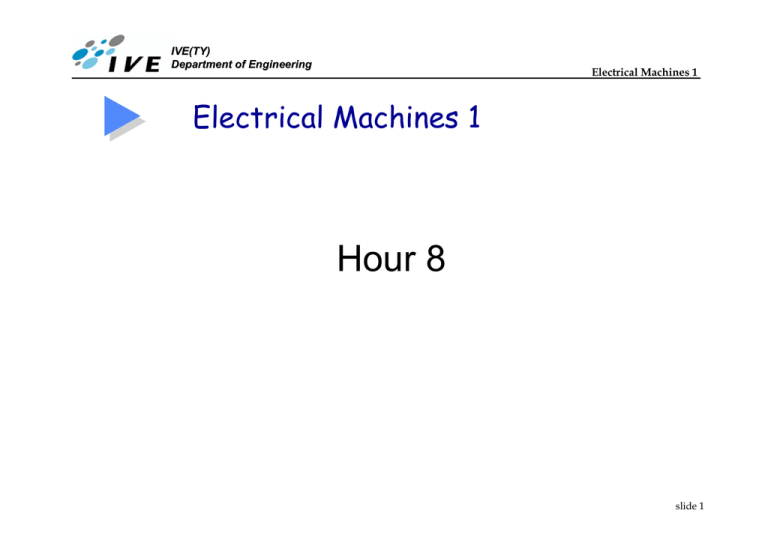Transformer Fundamental
advertisement

IVE(TY) Department of Engineering Electrical Machines 1 Electrical Machines 1 Hour 8 slide 1 IVE(TY) Department of Engineering Electrical Machines 1 Transformer Introduction • Transformer is a machine that has no moving parts but is able to transform alternating voltages and currents from high to low (step-up transformer ) and vice versa (step-down transformer). • Transformers are used extensively in all branches of electrical engineering from the large power transformer employed in the T&D network to the small transformer of an electronic amplifier slide 2 IVE(TY) Department of Engineering Electrical Machines 1 Transformer Introduction (cont) • A simple transformer consists of two coils wound on a closed iron core as shown: Primary Secondary slide 3 IVE(TY) Department of Engineering Electrical Machines 1 Construction of Transformer Basically, a transformer has two windings: • primary winding • Secondary winding Each winding consists of many turns and are wound on a laminated iron core. The iron core is insulated with the windings. The core itself forms a closed iron magnetic circuit. Consequently, the windings encircle the core and the core encircles the windings. slide 4 IVE(TY) Department of Engineering Electrical Machines 1 Construction of transformer • Core type -- windings are wound around two legs of a magnetic core. slide 5 IVE(TY) Department of Engineering Electrical Machines 1 Construction of transformer • Shell type -- windings are wound around the center leg of a three-legged magnetic core slide 6 IVE(TY) Department of Engineering Electrical Machines 1 Ideal Transformer Assumptions: 1. The winding resistances are negligible (R = 0) 2. All fluxes are confined to the core and link both windings (leakage flux = 0) 3. Permeability of the core is infinite (Iφ1= 0) 4. No eddy current and hysteresis losses slide 7 IVE(TY) Department of Engineering Electrical Machines 1 Ideal Transformer (cont) When an A.C. voltage v1 applied to the primary winding: dΦ v1 = e1 = N1 − − − − − − − (1) dt The core flux also links the secondary winding, then: dΦ v2 = e 2 = N2 − − − − − − − (2) dt From equations (1) and (2): v1 N1 = =a v2 N2 slide 8 IVE(TY) Department of Engineering Electrical Machines 1 Ideal Transformer (cont) • when a load is connected to the secondary winding, i2 will flow and will provide an mmf N2i2 for the core. • i1 would immediately flow to establish another mmf N1i1 to oppose N2i2 since no mmf is required to establish a flux in the ideal core Then: N1i1 − N2i2 = 0 N1i1 = N2i2 i1 N2 1 = = i2 N1 a slide 9 IVE(TY) Department of Engineering Ideal Transformer Electrical Machines 1 (cont) If the supply voltage is sinusoidal, then in rms values: V1 N1 = =a V2 N2 I1 N2 1 = = I2 N1 a V1I1 = V2I2 input VA = output VA slide 10 IVE(TY) Department of Engineering Electrical Machines 1 Emf Equation of a Transformer (1/2) Φ = Φm sin2πft instantaneous value of induced emf / turn = − dΦ/dt volts = − 2πftΦm cos2πft volts = 2πftΦm sin(2πft − π/2) volts slide 11 IVE(TY) Department of Engineering Electrical Machines 1 Emf Equation of a Transformer (2/2) rms value of induced emf / turn = 0.707 x 2πftΦm volts = 4.44 x fΦm volts Hence E1 = 4.44N1fΦm volts E 2 = 4.44N2fΦm volts E1 N1 = E 2 N2 slide 12 IVE(TY) Department of Engineering Electrical Machines 1 Example A 200kVA, 6600/400V, 50 Hz single-phase transformer has 80 turns on the secondary. Calculate: (a) the approximate values of the primary and secondary currents; (b) the approximate number of primary turns; and (c) the maximum value of the flux. Ans: 30.3A, 500A; 1320; 0.0225Wb slide 13 IVE(TY) Department of Engineering Electrical Machines 1 Phasor Diagram of Ideal Tx under No-load V1 = – E1 Im1 Φ E2=(N2 / N1) x E1 E1 slide 14 IVE(TY) Department of Engineering Electrical Machines 1 Electrical Machines 1 Hour 9 slide 15 IVE(TY) Department of Engineering Practical Transformer Electrical Machines 1 (sect 2.2) • the windings have resistances • not all windings link the same flux • permeability of the core material is not infinite, and core losses occur when the core material is subjected to time-varying flux slide 16 IVE(TY) Department of Engineering Electrical Machines 1 Development of the Transformer Equivalent Circuit • Considering the winding resistances and the leakage flux slide 17 IVE(TY) Department of Engineering Electrical Machines 1 Development of the Transformer Equivalent Circuit (cont) • Equivalent circuit obtained when the winding resistances and the leakage flux are being considered slide 18 IVE(TY) Department of Engineering Electrical Machines 1 Development of the Transformer Equivalent Circuit (cont) • Equivalent circuit obtained when the core loss and magnetizing inductance are being added slide 19 IVE(TY) Department of Engineering Electrical Machines 1 Phasor Diagram (No-load) slide 20 IVE(TY) Department of Engineering Electrical Machines 1 Phasor Diagram (On-load) Negligible voltage drop in windings slide 21 IVE(TY) Department of Engineering Electrical Machines 1 Example A 1-φ transformer has 1000 turns on the primary and 200 turns on the secondary. The no-load current is 3A at a power factor 0.2 lagging. Calculate the primary current and the power factor when the secondary current is 280A at a power factor of 0.8 lagging. Assume the voltage drop in the windings to be negligible. Ans: I1= 58.3A, cosφ1=0.78 lag slide 22 IVE(TY) Department of Engineering Electrical Machines 1 Phasor Diagram (On-load) Include voltage drop in windings slide 23 IVE(TY) Department of Engineering Electrical Machines 1 Electrical Machines 1 Hour 10 slide 24 IVE(TY) Department of Engineering Electrical Machines 1 Impedance Transfer The impedance of the secondary winding, Z2 V2 Z2 = I2 The input impedance, Z1 V1 aV2 2 V2 Z1 = = =a I1 I2 /a I2 = a Z2 2 = Z'2 slide 25 IVE(TY) Department of Engineering Impedance Transfer Electrical Machines 1 (cont) An impedance Z2 connected in the secondary will appear as an impedance Z’2 looking from the primary slide 26 IVE(TY) Department of Engineering Impedance Transfer Electrical Machines 1 (cont) An impedance from the primary side can also transferred to the secondary side, and in that case its value has to be divided by the square of the turns ratio 1 Z'1 = 2 Z1 a Impedance transfer is very useful because it eliminates a coupled circuit in an electrical circuit and thereby simplifies the circuit slide 27 IVE(TY) Department of Engineering Electrical Machines 1 Referred Equivalent Circuit • Equivalent circuit when secondary resistance and reactance are referred to the primary slide 28 IVE(TY) Department of Engineering Referred Equivalent Circuit Electrical Machines 1 (cont) With all quantities (voltages, currents, and impedances) referred to the primary slide 29 IVE(TY) Department of Engineering Electrical Machines 1 Approximate Equivalent Circuit An approximate equivalent circuit slide 30 IVE(TY) Department of Engineering Electrical Machines 1 Example A 100 kVA transformer has 400 turns on the primary and 80 turns on the secondary. The primary and secondary resistances are 0.3Ω and 0.01Ω respectively, and the corresponding leakage reactances are 1.1Ω and 0.035Ω respectively. Calculate the equivalent impedance referred to the primary circuit. Re =0.55Ω, Xe = 1.975Ω, Ze = 2.05Ω slide 31 IVE(TY) Department of Engineering Electrical Machines 1 Electrical Machines 1 Hour 11 slide 32 IVE(TY) Department of Engineering Electrical Machines 1 Voltage Regulation (sect. 2.3) • Any source having internal impedance suffers a change in voltage when supplied power to a load. • With power transformers, this is important because there is a legal limit by which the voltage at the consumer terminals may vary. (i.e. ± 6 %) V.R. = V2 NL − V2 L V2 L OR V.R. = V1 − V'2 rated V'2 rated slide 33 IVE(TY) Department of Engineering Example 2.3 Electrical Machines 1 (page 60) Consider the transformer in Example 2.2. Determine the voltage regulation in percentage for the following load conditions. (a) 75% full load, 0.6 power factor lagging. (b) 75% full load, 0.6 power factor leading. (c) Draw the phasor diagram for condition (a) and (b). slide 34 IVE(TY) Department of Engineering Electrical Machines 1 Transformer Losses • Copper losses ( I2R losses ) in primary and secondary windings PC = I12 R1 + I22 R2 • Iron losses ( Core losses ) (a) Hysteresis loss Ph = KhBmaxx f V watts where Kh= a constant f = frequency V = Volume Bmax = maximum flux density x = coefficient varies from 1.6 - 2.0 with different grades of iron. slide 35 IVE(TY) Department of Engineering Electrical Machines 1 Transformer Losses • Iron losses ( Core losses ) (b) Eddy Current loss Pe = KeBmax2 f2 t2 V watts where Ke= a constant f = frequency V = Volume Bmax = maximum flux density t = thickness of lamination. Total iron losses, Pi = Ph + Pe slide 36 IVE(TY) Department of Engineering Transformer Efficiency Electrical Machines 1 (sect. 2.4) Output power Efficiency = Input power Output power = Output power + losses Output VA × power factor η = Output VA × power factor + core loss + I 2 R losses slide 37 IVE(TY) Department of Engineering Electrical Machines 1 Electrical Machines 1 Hour 12 slide 38 IVE(TY) Department of Engineering Transformer Tests Electrical Machines 1 (sect. 2.2.2) Open Circuit test • this test is performed by applying a voltage to either the HV side or LV side, whichever is convenient • during the test, secondary winding is kept open-circuited slide 39 IVE(TY) Department of Engineering Electrical Machines 1 Transformer Tests Open Circuit test (cont) • the primary current is the exciting current and the losses measured by the wattmeter are the core losses • core losses are essentially a fixed loss which depends on the maximum value of flux in the core and the supply frequency, but not the load slide 40 IVE(TY) Department of Engineering Electrical Machines 1 Transformer Tests Short Circuit test • this test is performed by short-circuiting one winding and applying rated current to the other winding • only a small supply voltage is required to pass rated current through the windings • it is usual to perform this test by applying a voltage to the HV side slide 41 IVE(TY) Department of Engineering Electrical Machines 1 Transformer Tests Short Circuit test (cont) • the parameter Req and Xeq can be determined from the readings of voltmeter, ammeter, and wattmeter • because the voltage applied under the shortcircuit test is small, the core losses are neglected and the wattmeter reading can be taken entirely to represent the copper losses in the windings, represented by Req slide 42 IVE(TY) Department of Engineering Example 2.2 Electrical Machines 1 (page 55) Tests are performed on a 1φ, 10 kVA, 2200/220 V, 60 Hz transformer and the following results are obtained. (a) Derive the parameters for the approximate equivalent circuits referred to the LV side and the HV side. (b) Express the excitation current as a percentage of the rated current. (c) Determine the power factor for the no-load and short-circuit tests. slide 43 IVE(TY) Department of Engineering Electrical Machines 1 Electrical Machines 1 Hour 15 slide 44 IVE(TY) Department of Engineering Auto-transformer Electrical Machines 1 (sect. 2.5) • transformer having a part of its windings common to the primary and secondary • when a load is connected across b and c, then a current I2 will flow through the load. The current I2 will produce an m.m.f. in the core which will be balanced by a current I1 flowing in the complete winding slide 45 IVE(TY) Department of Engineering Electrical Machines 1 Auto-transformer The voltages and currents are related by the same turns ratio as in a two-winding transformer: V1 N1 = =a V2 N2 I1 N2 1 = = I2 N1 a slide 46 IVE(TY) Department of Engineering Example 2.6 Electrical Machines 1 (page 67) A 1φ, 100 kVA, 2000/200 V two-winding transformer is connected as an autotransformer as shown in Fig. E2.6 such that more than 2000 V is obtained at the secondary. The portion ab is the 200 V winding, and the portion bc is the 2000 V winding. Compute the kVA rating as an autotransformer. slide 47 IVE(TY) Department of Engineering Example 2.6 Electrical Machines 1 (cont) The current rating of the winding are: 100,000 I ab = = 500 A 200 100,000 I bc = = 50 A 2,000 Therefore, for full-load operation of the autotransformer, the terminal currents are: I H = 500 A I L = 500 + 50 = 550 A slide 48 IVE(TY) Department of Engineering Electrical Machines 1 Example 2.6 (cont) Now, VL = 2000V and VH = 2200V Therefore, kVA |L = 2000 × 550 = 1100 (ans) 1000 kVA |H = 2200 × 500 = 1100 (ans) 1000 Note: A 1φ, 100 kVA, two-winding transformer when connected as an autotransformer can deliver 1100 kVA. slide 49 IVE(TY) Department of Engineering Electrical Machines 1 Advantages of Auto-transformer • It effects a saving in winding material (copper or aluminum), since the secondary winding is part of the primary current. • Lower copper loss, therefore efficiency is higher than in the two winding transformer. • Lower leakage reactances, lower exciting current. • Variable output voltage can be obtained. slide 50 IVE(TY) Department of Engineering Electrical Machines 1 Disadv. of Auto-Transformer • There is a direct connection between the primary and secondary sides. • Should an open-circuit develop between points b and c, the full mains voltage would be applied to the secondary. • The short-circuit current is much larger than for normal two-winding transformer slide 51 IVE(TY) Department of Engineering Electrical Machines 1 Application of Auto-transformer • Boosting or bucking of a supply voltage by a small amount. (The smaller difference voltage between the output and input voltages the greater is the saving of winding material.) • Starting of a.c. machines, e.g. induction motor, where the voltage is raised in two or more steps from a small value to the full supply voltage. • Continuously variable a.c. supply voltages, normally connected between a low voltage supply in and a high voltage supply out. • Production of very high voltages, e.g. 275kV and 400kV grid system slide 52 IVE(TY) Department of Engineering Electrical Machines 1 Instrument Transformers • Voltage Transformer VT (or PT) – N1/N2 is large and standard 110 V at the secondary. • Current Transformer CT – N1/N2 is small and standard 5 A or 1A at the secondary. • Reduce the voltage or current magnitudes so that instruments can be used. • Instruments are connected to the secondary of the transformers. • The measured values should then be multiplied by the appropriate turns ratio to get the actual primary values. slide 53 IVE(TY) Department of Engineering Electrical Machines 1 Reasons for using Instrument Transformer • do not require special designed instruments for h.v. or heavy current measurements • for safety reason, one terminal secondary winding can be earthed • electrical isolation achievable from the of the primary is slide 54 IVE(TY) Department of Engineering Electrical Machines 1 About the Use of Instrument Transformer • may have turns ratio error • phase shift may exist between primary and secondary measurands • CT is actually a step-up transformer with very large turns ratio (eg 500/1), excessive voltage will exist between the secondary terminals if they were left open. • NEVER LET THE SECONDARY OF A C.T. OPEN-CIRCUITED slide 55



